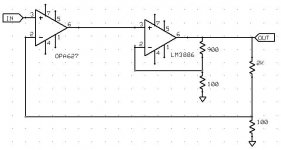Hi all,
I have recently been considering a new approach at the gainclone that would likely yield better results that prior designs.
The idea is this: Utilize the chipamp (for example's sake the LM3886) inside the feedback loop of a good audio op-amp such as the OPA627.
Minor issues arise due to the fact that the 627 needs say +/-15V whereas the 3886 needs say +/-35V. The 627 only has output swing of +/-10V in any case so it would just not work to use the 3886 as unity-gain current amplifier while the 627 performs the VA duties (you would not get enough power... 🙂 ) not to mention the fact that the 3886 is only "stable" at gains of 10 or more.
Seeing that the gain on most chipamp designs is 21 or similar, why not setup the gainclone with a gain of 10, and enclose the entire existing gainclone inside the feedback loop of a 627 with a gain of 21?
So, with a 1V input, you would have a 21V output....the 3886 with a gain of 10 means that the 627 only produces 2.1V for every 1V of input and keeps it well within output swing constraints.
And because the gainclone would be within the feedback loop of the 627 fidelity would be improved and an overall better amplifier would be produced.
See my simplified schematic....the 627 would be run on regulated +/-15V taken from the 3886's rails so only one transformer is needed.
Thoughts?
-Matt
I have recently been considering a new approach at the gainclone that would likely yield better results that prior designs.
The idea is this: Utilize the chipamp (for example's sake the LM3886) inside the feedback loop of a good audio op-amp such as the OPA627.
Minor issues arise due to the fact that the 627 needs say +/-15V whereas the 3886 needs say +/-35V. The 627 only has output swing of +/-10V in any case so it would just not work to use the 3886 as unity-gain current amplifier while the 627 performs the VA duties (you would not get enough power... 🙂 ) not to mention the fact that the 3886 is only "stable" at gains of 10 or more.
Seeing that the gain on most chipamp designs is 21 or similar, why not setup the gainclone with a gain of 10, and enclose the entire existing gainclone inside the feedback loop of a 627 with a gain of 21?
So, with a 1V input, you would have a 21V output....the 3886 with a gain of 10 means that the 627 only produces 2.1V for every 1V of input and keeps it well within output swing constraints.
And because the gainclone would be within the feedback loop of the 627 fidelity would be improved and an overall better amplifier would be produced.
See my simplified schematic....the 627 would be run on regulated +/-15V taken from the 3886's rails so only one transformer is needed.
Thoughts?
-Matt
Attachments
Matt, this connection will be not stabil. You can't connect slower circuit into feedback loop, only in case, if is first opamp " slow down " by local feedback. But in this case uprise distortion at high frequency, so result will be not good.
- Status
- Not open for further replies.
